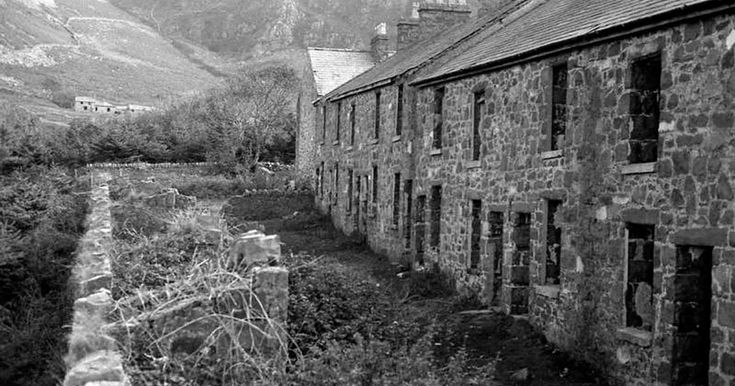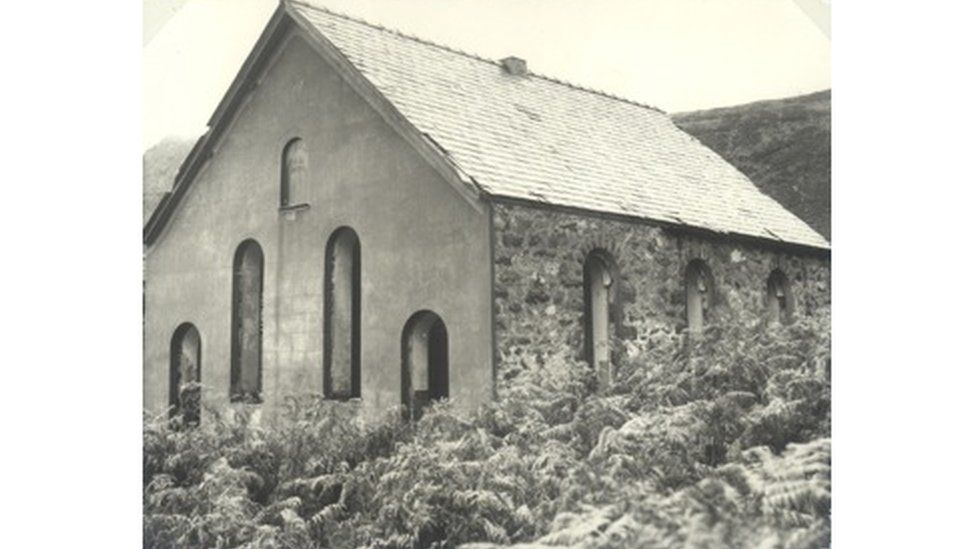Nant Gwrtheyrn
Ten thousand years ago saw the end of the last Ice Age, marking the end of about 90,000 years.
This valley was filled with ice, it is formed due to from softer land being removed, leaving the
 Nant from the above
hard granite and manganese behind to form and shape the valley. Granite has been the main
source of livelihood for the inhabitants of the area for nearly two hundred years. If you go
down the road to Nant Gwrtheyrn, you’ll see y Graig Ddu (the Black Rock) facing the sea. Y
Graig Ddu is a rich source of manganese, and during the Golden Age of shipping, experienced
captains would have to be careful when passing the valley, on account of he manganese in the
rock disrupting the ships' compasses, and, sometimes, the rock itself would behave like a
magnet. The former quarrying village of Nant Gwrtheyrn is nestled in the shadow of y Graig
Ddu.
Nant from the above
hard granite and manganese behind to form and shape the valley. Granite has been the main
source of livelihood for the inhabitants of the area for nearly two hundred years. If you go
down the road to Nant Gwrtheyrn, you’ll see y Graig Ddu (the Black Rock) facing the sea. Y
Graig Ddu is a rich source of manganese, and during the Golden Age of shipping, experienced
captains would have to be careful when passing the valley, on account of he manganese in the
rock disrupting the ships' compasses, and, sometimes, the rock itself would behave like a
magnet. The former quarrying village of Nant Gwrtheyrn is nestled in the shadow of y Graig
Ddu.
Vortigern was a king of the Britons, and a fifth century warlord. Whether he is a historical
character or not is uncertain. According to tradition, it is said that he was responsible for
inviting the Saxons to the British Isles. According to Nennius, Hengist invited Vortigern and his
courtiers to a feast at his court. It was all to murder the Britons to occupy the British Isles.
Vortigern was besotted with Hengist's daughter Rowena, and therefore he agreed to the feast.
 The houses before their renovation
Hengist took advantage of this and asked everyone to come to the feast without weapons. On
Hengist's order, during the feast, the Saxons, who were scattered amongst the Britons at the
tables, drew their long knives and killed three hundred of the Britons. Vortigern had no choice
but to surrender his right on southern Britain to the Saxons and flee, along with the rest of his
people to a secluded corner in Wales.
The houses before their renovation
Hengist took advantage of this and asked everyone to come to the feast without weapons. On
Hengist's order, during the feast, the Saxons, who were scattered amongst the Britons at the
tables, drew their long knives and killed three hundred of the Britons. Vortigern had no choice
but to surrender his right on southern Britain to the Saxons and flee, along with the rest of his
people to a secluded corner in Wales.
In the eighteenth century, Thomas Pennant says in his book 'Tours of Wales' there were three farms that were in the valley, and the ruins of all three can still be seen to this day namely Tŷ Hen, Tŷ Canol and Tŷ Uchaf.
Rhys Maredudd lived in Tŷ Uchaf. He was to marry Meinir. On the day of the wedding, Meinir
went into hiding, as was customary in those days. Rhys and his groomsmen, who were meant to
find her, and bring her to church, failed to do so. Meinir had disappeared. Some years later and
driven mad after losing Meinir and wished he could see her again, Rhys went to sit on a slope
by an old tree. A bolt of lightning struck the old tree, splitting it in half. In the hollow tree, was
Meinir's skeletal remains, still in her wedding dress. On her wedding day, all those years ago,
 The old chapel
she hid in the tree and failed to get out. Some say that a grief-stricken Rhys died instantly of a
broken heart, others claim that a second bolt of lightning struck him, killing him on the spot.
About a hundred years ago, the villagers chose Brenin y Nant (King of Nant) from amongst
them, and he had the last word on anything and everything concerning village life. Everyone
used to turn to him for advice.
The old chapel
she hid in the tree and failed to get out. Some say that a grief-stricken Rhys died instantly of a
broken heart, others claim that a second bolt of lightning struck him, killing him on the spot.
About a hundred years ago, the villagers chose Brenin y Nant (King of Nant) from amongst
them, and he had the last word on anything and everything concerning village life. Everyone
used to turn to him for advice.
From time to time. The wild goats are seen on the haggard slopes and the Chough cawing overhead. The Chough is the symbol used by an Area of Outstanding Natural Beauty and the wild goats have roamed the area since the days of the last Ice Age and are an integral part of our natural history ever since.